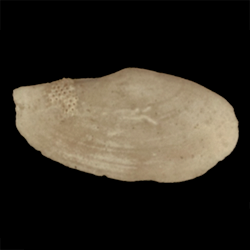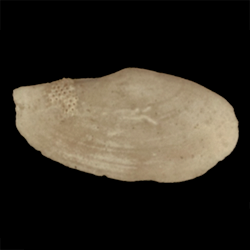
Yoldiidae

- Phylum: Mollusca
- Class: Bivalvia
- Order: Nuculanida
- Family: Yoldiidae
Overview
Common name: Yoldias
Key morphological features: The Yoldiidae are medium sized, up to ~60 mm. The shells are equivalve, thin-walled, and elongated oval in shape. The posterior end is extended and the shell usually gapes at both ends. The shell is composed of aragonite, and exterior sculpture is typically glossy and smooth, with fine commarginal lines. Valve interiors are non-nacreous and the pallial line has a deep sinus. The interior shell margins are smooth. Species of Yoldiidae are isomyarian, and both well-defined adductor muscles are equal in size. The arched taxodont hinge has chevron-shaped anterior and posterior teeth. Source: Mikkelsen, P.M., and Bieler, R. 2008. Seashells of Southern Florida: Bivalves. Princeton, New Jersey: Princeton University Press. 503 pp.
Geological range: Cretaceous to Recent (Mikkelsen & Bieler, 2008).
Geographic distribution: A distributional map for modern Yoldiidae may be accessed from OBIS. A distributional map for ancient Nuculanidae may be accessed from the Paleobiology Database.
Diversity: There are 161 recognized living species of Yoldiidae and 10 genera (WoRMS database, unvetted). The Paleobiology Database recognizes 2 fossil genera and 56 fossil species of Nuculanidae (unvetted).
Paleoecology: The Yoldiidae are marine deposit feeders that can supplement their diet with limited suspension feeding. They live infaunally, buried in sand or mud, and typically feed by excavating subsurface chambers with their palps. Yoldiids are rapid and strong burrowers, and play a major role in sediment bioturbation. They can be found commonly throughout the world's oceans, where they play a large role in the food chains of commercial fish. Source: Mikkelsen and Bieler (2008).
Phylogenetic status: Polyphyletic. The molecular phylogenetic analysis by Sharma et al. (2013) supports the polyphyly of Family Yoldiidae as an assemblage of at least three lineages.
